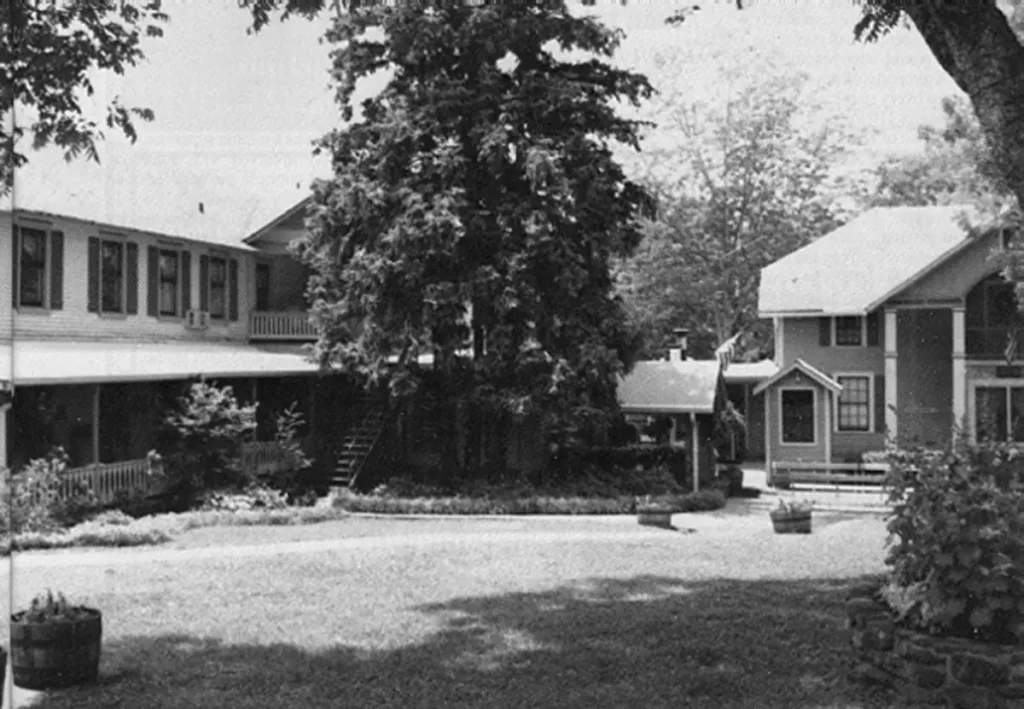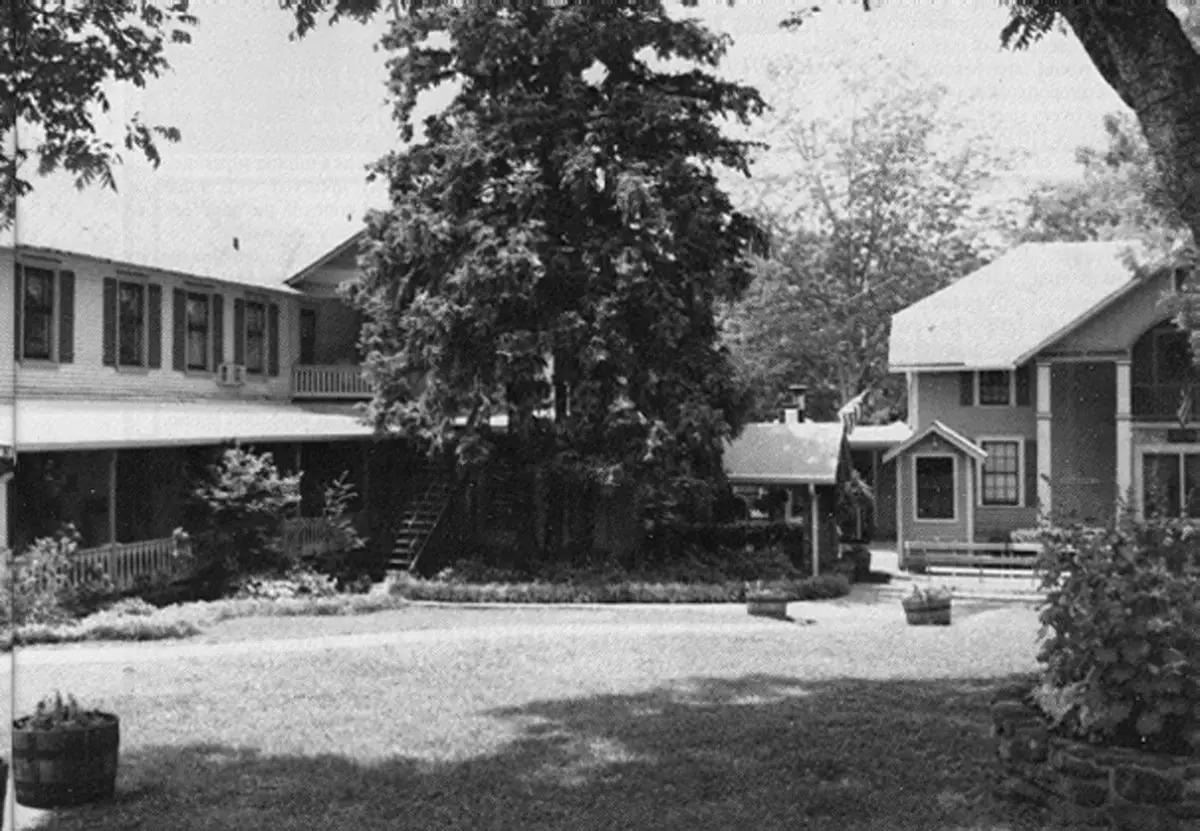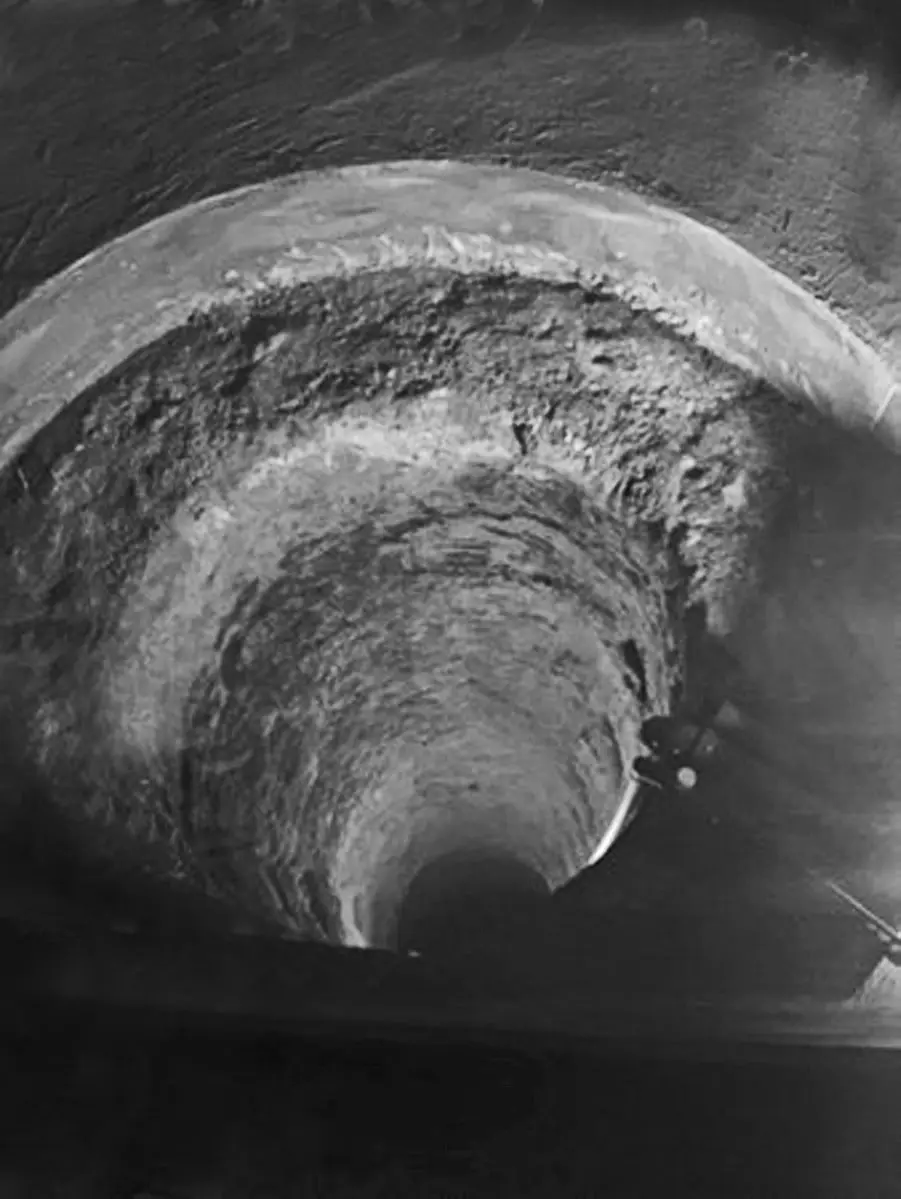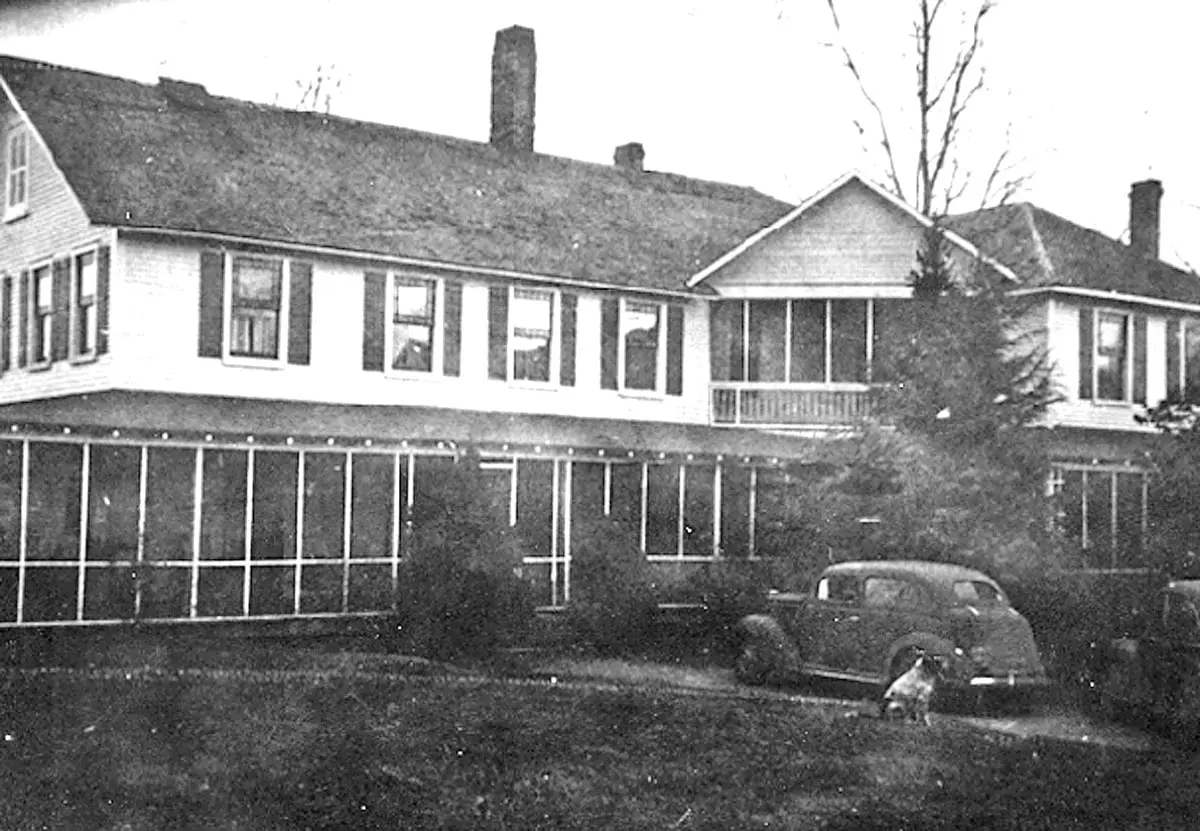As of the year 2024, the inexplicable gold mine had secretly existed beneath the basement of the famous Smith House Restaurant in Dahlonega for almost 125 years. It is unknown today why the original owner – Capt. Frank W. Hall – did not mine all the gold in the vein, or why he chose to seal it up as a secret in perpetuity. It is known, however, that he mined this gold surreptitiously, in violation of Lumpkin County law, becoming wealthier yet than he already was.
On February 14, 2006, a mysterious mine shaft was amazingly uncovered by workmen in the basement of the historic Smith House Restaurant in Dahlonega, Georgia. Interestingly, there had been, for many years, a legend concerning the structure’s original builder and his discovery of a rich vein of gold beneath his home, but the 2006 revelation of a large concealed mine tunnel with un-mined gold came not only as a surprise, but a complete shock to the present-day owners.
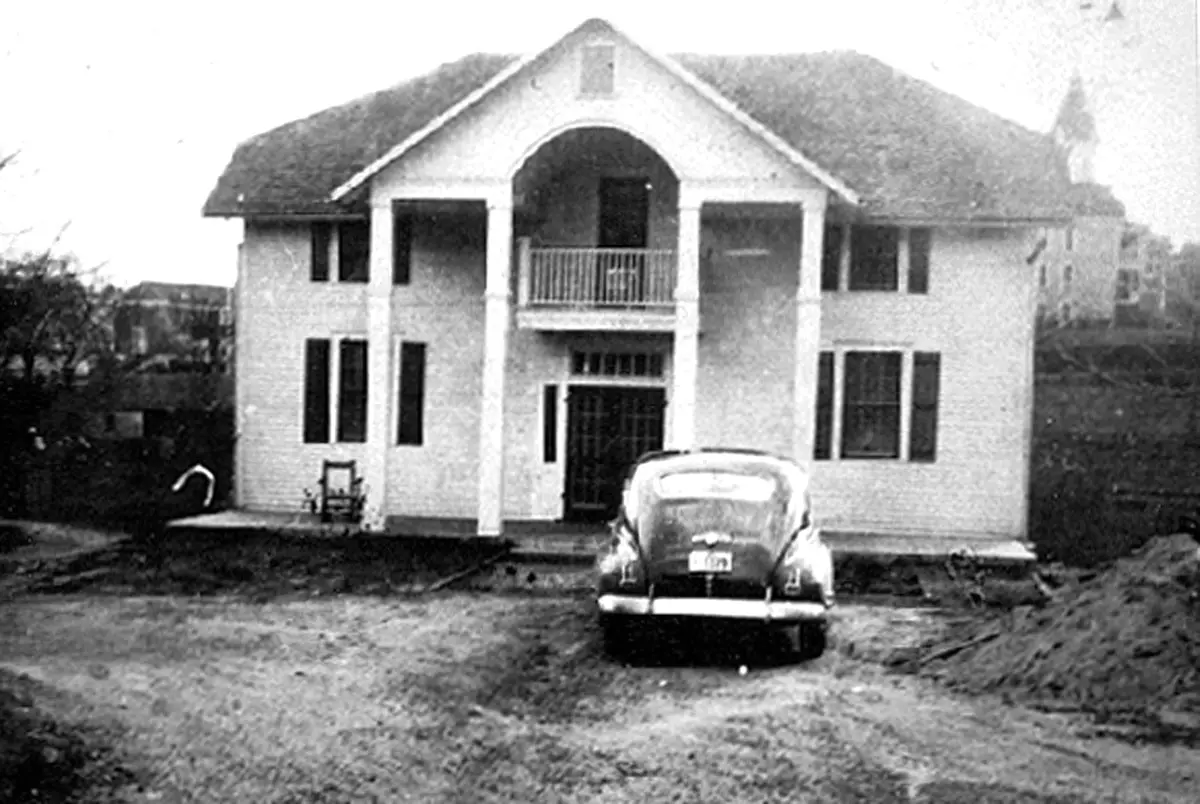
Capt. Frank W. Hall had moved from Vermont to Dahlonega in 1868 shortly after the end of the U.S. Civil War. He was employed by The Boston Massachusetts Company to oversee several local gold mills and mining operations in the Lumpkin County vicinity owned by the company.
Despite the fact that Hall was almost penniless when he arrived in Dahlonega, he, supposedly – as a result of his sharp business acumen – eventually became one of the most influential and wealthy men in the county, acquiring numerous tracts of property and businesses, including a fine home which he constructed just off the Dahlonega town square.
The discovery of the secret gold mine beneath Hall’s former property indicates that though he may have indeed enjoyed a sharp knack for business, he also enjoyed a secret source of income for the accumulation of at least a portion of his immense wealth.
Hall had purchased the property on which he built his home (later known as the Smith House) in 1895. By 1899, having already made his mark in the Dahlonega community, Hall had completed construction of his rambling farmhouse abode just off the town square, and had been busy with his assaying business inside the structure for a number of months.
Hall’s mysterious mine shaft was later discovered beneath what once was the old dining room of the Smith House Restaurant in which the late Fred and Thelma Welch had served thousands of guests from the 1950s right up until the 1990s. The immense opening of the mine shaft had been sealed up with a concrete cap at some point in time, but, surprisingly, probably NOT by Hall prior to his departure in 1900.
The Welchs’ son – Freddie – eventually assumed the reins of ownership and management of the renowned Dahlonega eatery in later years, and maintains he had heard rumors of a gold mine somewhere on the property all his life, but no one had ever known the actual location of the mine. It was Freddie who initiated the renovation at the Smith House which ultimately uncovered the secret mine.
News of the gold-mining shaft apparently had leaked out back in Hall’s day, because the rumors had persisted through the decades since Hall’s departure, but even those “in the know,” apparently did not know exactly where the mine was located – or, if they did, they weren’t forthcoming with the information.
Origin of the Mine
Hall had originally discovered the gold vein beneath his property in 1899 as he was digging the cellar for his new home, but had either agreed to placate the town fathers by not mining the gold in the vein, or, had been forbidden by the town fathers from pursuit of the gold in the vein because it was located within the city limits and would therefore violate city codes.
In the early days of mining in the Dahlonega area in the mid-1800s, Lumpkin County was pock-marked with mines. In “downtown” Dahlonega, mines once even existed in the middle of town streets. Town fathers eventually realized they must forbid mining within the city limits or risk the collapse of untold numbers of real estate into the shafts dug in the rabid pursuit of the precious metal.
An excerpt from the November 3, 1899 issue of the Dahlonega Nugget newspaper by Editor W. B. Townsend reads as follows:
“Captain Hall’s workmen, while excavating the cellar for his new warehouse on the corner of Chestatee and Waters Street, just across from R.H. Webb’s lot, struck a rich gold-bearing vein several feet wide, depth not known.”
Editor Townsend went on to note that Capt. Hall had informed him that he would not develop the vein since it ran under his building and was on a town lot. Townsend also noted that Hall had stated that he didn’t have any time to spend working a gold mine!
Today, Hall’s claim must be considered – at best – to have been subterfuge. His public proclamation of his lack of interest in pursuit of the substantial gold on his property is simply unbelievable, particularly since it emanated from a man who had originally relocated to Dahlonega specifically as a mining superintendent with expertise in mining and who had ultimately been involved with numerous local gold mines in the area for three decades.
It is known today that, in fact, at the very least, Hall did not initially just volunteer to ignore the rich gold vein on his property. He in actuality waged a six‑month legal battle with the City of Dahlonega – which he lost – in a vain attempt to gain the right to mine the gold.
After losing the lawsuit, Hall supposedly covered up his gold vein with the fine structure known today as the Smith House and simply walked away from the riches. At least this was the image he presented to the town fathers.
Today, however, we know to the contrary, that though he may in fact have begun construction of the edifice – which later became the Smith House Restaurant – initially as a home, he ultimately had no intention of actually residing in it after losing his court case. It would simply have been too difficult to do so and simultaneously conceal his illicit gold mining activities – which he had obviously made up his mind to pursue.
In point of fact, Hall had decided to use the new structure officially as an assaying office during the day, while maintaining it as a shelter to surreptitiously mine his gold in the cellar – probably during the evening hours. Though he was a law-abiding and highly respected citizen, Frank Hall apparently wasn’t about to allow a little city ordinance to deny him the riches to which he felt he was rightfully entitled.
The May 18, 1900 issue of the Nugget reported on Hall’s new digs: “Frank W. Hall moved his office last week into his new building and is living in what is known as ‘Hope House.’” The office to which the quotation refers was Hall’s professional assay office for testing gold which was located in the present-day Smith House Restaurant building. This business operation no doubt made it very convenient for him to assay the ore of other miners during the day, while also openly processing as well – under the same auspices – the gold-bearing soil from his own concealed gold mine. After all, the process of assaying the gold-bearing soils of other individuals was the same as processing the soil from his own mine. It was so simple, and none of the town officials apparently suspected a thing was amiss.
The Mystery Deepens
Interestingly, this raises yet another question. How was Frank Hall actually able to mine and process his gold ore single-handedly? The answer undoubtedly is, he didn’t. He almost had to have had an accomplice – or accomplices. After all, it would have been an almost overwhelming chore for him to have mined all that gold bearing soil and then to have hauled it up out of his mine shaft beneath the floor of his home himself.
So who actually mined and hauled the large quantities of gold ore? Did Hall use someone nearby who he paid off to remain quiet? This undoubtedly will remain yet another part of the mystery of this unusual enterprise. In retrospect, it perhaps should not be considered such a surprise that a secret of this magnitude could have been maintained for so many years. After all, those assisting Hall in the surreptitious illicit project were just as guilty legally as was he, so they had good reason to remain silent.
There are a number of other unexplained aspects of Hall’s secret venture as well which few if any investigators and speculators of this mysterious mining endeavor have entertained. These include:
1/ Who labored the many hours it must have required to secretly dig the immense mine shaft beneath Hall’s home?
2/ Who actually removed all the spoil and gold ore from that deep shaft?
3/ Where, in fact, was all that gold ore secretly processed if not right there on Hall’s residential property?
4/ How much did his accomplices profit from this venture?
5/ Were these accomplices bribed, or did they participate in this task purely motivated by profit?
6/ What became of these accomplices?
7/ How did Hall successfully achieve these substantial tasks without any of his business associates, friends, or family knowing of his actions, particularly since these actions were obviously illegal?
All of these questions continue to add to the mystique of Frank Hall. They quite likely will never be solved.
The Historic Hope House
Interestingly, the “Hope House” to which the Nugget article referred above, was a structure which once stood in the vicinity of the present-day parking lot of the Smith House Restaurant. Even though the Hopes only lived in this structure for a brief few years, it has been forever associated with them as “the Hope House.” Mule skinner A.A. Hope purchased the abode as a residence for his family in 1884.
As Dahlonega’s oldest surviving domestic structure still in its original location, the historic Hope House, unfortunately, was removed in 1985 from its location at the Smith House property when the decision was made that more space was needed at the highly-popularized Dahlonega eatery. It (the Hope House) was relocated to what once was known as Mountain Music Park on the south side of nearby Crown Mountain, and its disposition at the time of this writing is unknown.
Due to stringent efforts more recently at preservation of the historic structures and sites in and around Dahlonega, any effort today toward the removal of a structure such as the Hope House would undoubtedly receive more careful consideration by a more preservation-minded town leadership. A number of recent attempts at the removal of historic structures for the erection of new developments have been met with strident opposition by the town’s leadership for understandable reasons. After all, it is the historic charm of Dahlonega which makes it such a popular travel destination today.
Frank Hall’s Departure
It is unknown today why Frank Hall did not completely mine all the gold in the rich vein beneath his home, or why he chose eventually to seal up and conceal the opening to the shaft. Smith House owner Freddie Welch has stated that he had samples of the gold ore from the mine assayed shortly after its discovery, and the results indicated that the gold from the vein therein not only is far from depleted, but is quite rich as well.
When queried why he would not pursue the mining of the gold in the secret shaft himself, Welch apparently indicated that there is much more “gold” in a thriving tourism and dining destination such as the Smith House, than there would be in a small gold mine.
So why did Hall just “pull up stakes” and pull out of town in 1900? Perhaps he had simply accumulated all the wealth he felt he needed from his secret mine and investments in order to be able to comfortably live out the remainder of his life. Perhaps he just decided that “enough is enough” and sealed up the mine to hide his illicit endeavor.
Speculators have also suggested that perhaps Hall had come to the realization that he or his wife was suffering from a serious health condition, a circumstance which may have altered forever his priorities in life. Just as with many of the other mysteries of Hall’s life, these riddles now will also never be solved.
Though Hall’s substantial home just off the Dahlonega town square was relatively modern for its day and time and designed to be the “new quarters” for him and his wife, Esther, the couple never occupied the premises as a home. Instead, after Hall had sealed up and hidden the mine shaft, he and Esther quietly moved to an area known as “Ingleside” near Atlanta – departing Dahlonega forever.
Interestingly – and sadly – despite what may have been immense illicit riches, Hall did not live long enough to enjoy much of the wealth he had accumulated. Shortly after his move to Atlanta in 1900, he died suddenly and unexpectedly at age 56 from typhoid fever, no doubt contracting the disease – ironically – from an impure water source in the over-crowded circumstances of the swiftly-recovering city which had risen from the ashes of the U.S. Civil War some 35 years earlier.
According to his obituary in the Dahlonega Nugget, Hall was described as “the richest person in Lumpkin County long before he decided to take up his new place of abode.” He was also a public‑spirited citizen who represented Lumpkin County in the Georgia State Legislature, Dahlonega in the mayor’s office, and North Georgia College as a member of the Board of Trustees.
Had the secret gold mine never been discovered, there might always have been a mystery surrounding the question of why Hall would have built such an impressive and inviting residential structure just off the town square in Dahlonega, only to take up residence instead in a smaller and much lesser-quality abode such as the Hope House. Today, Hall’s impetus is quite clear.
Another Departure Motivation?
According to the late Dahlonega historian Madeleine K. Anthony, another run‑in with the city fathers may also have had an impact on Hall’s decision to leave the city. According to Ms. Anthony, historic records indicate that the town fathers not only refused to grant Hall the right to mine the gold on his property, but also to install a new-fangled convenience known as “indoor plumbing” to which he was accustomed.
In that day and time in the South, indoor toilets were actually understandably considered unsanitary, since they consisted of what was known as a very odorous and unhygienic “outhouse.” The location of such a structure within the confines of one’s home – particularly in the hot and humid climate of the South – was so unacceptable as to be inconceivable. The odors and other prevailing detestable aspects of this option alone simply made it unthinkable.
Hall, however, had been born and raised in Vermont where it was far too cold in the winter months for one to use an outhouse, particularly if one had another option, and the Vermont Halls apparently had solved the problem by somehow moving “the throne” indoors to “heated” space while somehow also dealing with the detestable aspects of the circumstances.
Perhaps Hall had acquired one of the first “flush toilets” in the area and had intended to set up his “indoor john” with that “commodious” device. Whatever the successful circumstances he had developed for the indoor device, it apparently was a practice Hall had no doubt hoped to recreate in his Dahlonega home – and apparently had even specially set up his new home for such use – only to be denied once again by the city.
Those days in the late 1800s in Dahlonega were a time when the town offered no city water or sewage service whatsoever – right up even to the day the late Ben and Bessie Smith opened the original Smith House in 1922. The inn, however, did have its own well, with a pump powered by electricity generated by a giant water‑wheel at nearby Cane Creek Falls, and at least part of this infrastructure was courtesy of Frank Hall.
“There also were woodstoves in the lobby and in some of the rooms for winter guests,” the Smith’s son, the late Vernon Smith recalled prior to his passing. “One of my jobs was to cut and split wood to keep the stoves burning. I also had to milk the cows which we kept so our guests could have fresh milk and butter.”
Vestiges from Yesteryear
Unbeknownst by most guests today at the Smith House, the “carriage house” which once sheltered the livestock (horses) used by guests to pull their buggies and other conveyances to the popular inn and eatery in the early days still stands in the courtyard (to the right as one walks into the Smith House). The vehicles (buggies and carriages) were housed on the ground (front) level of the carriage house, and the livestock were taken to stalls in the rear lower level. Hay used to feed the horses was stored in the rear upper level.
Yet another surprise “uncovered” in the secret gold mine in its recent “discovery” were items such as a 1940s-era light bulb, indicating a later owner of the property apparently had earlier discovered the secret gold mining shaft and then, for reasons unknown today, also had covered it back over with a concrete cap.
What explanation might one draw from this curious occurrence? Did the individual who tossed in the 1940s-era light bulb assume he had simply discovered an old dry water well? We’ll never know the answer to that question either. Lots of unsolved mysteries.
Though Frank Hall is long gone today, the evidence of his former existence in Dahlonega – with historic “Hall’s Block” and “the Hall House” on the town square, the Smith House just off the town square, and the remnants of Hall’s Mill down on the Chestatee River – is still very visible today. And the mysterious circumstances surrounding the hidden mine shaft will no doubt live on in perpetuity.
